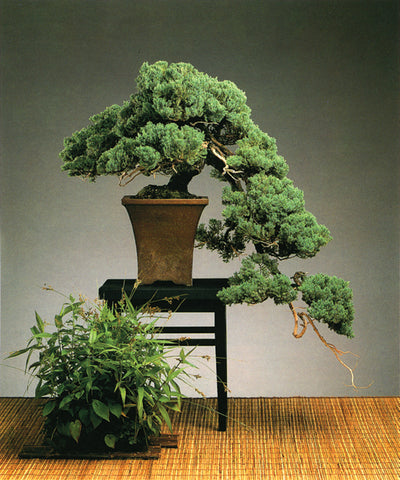About Juniper Bonsai Trees
The Juniper is the number one choice among bonsai buyers, particularly as gifts and beginner trees. It isn't surprising considering that when you think of a bonsai tree, the image that usually springs to mind is of an evergreen tree and of all the evergreen trees, nothing grows as easily as a Juniper.
Unlike other evergreen conifers like spruce or pine, the Juniper is the only tree that can live indoors BUT there are different kinds of Juniper and only Juniper procumbens "nana" will live indoors. The other two most commonly found bonsai junipers, Juniper Chinensis - the Chinese Juniper and it's very popular variety J. Chinensis "Shimpaku" better known as the Shimpaku Juniper or Sargent's Juniper MUST be kept outdoors.
Caring for a juniper kept indoors is relatively easy. If possible, let it spend the summer outdoors and during the winter months, give it bright, indirect sunlight, a slightly cool spot and enough water to keep it slightly moist- but not wet. It's also not a bad idea to mist your indoor juniper during the winter months as it is attractive to spider mites which like the dry air.
If you notice that your Juniper is looking brown, check first to be certain that you're not underwatering it, or overwatering (which will easily rot the roots). Then look for fine webs and tiny red mites.
The best way that I have found to shape Junipers is with a combination wiring and scissor trimming. As is the case with all conifers, never prune too heavily. A branch loses most of its foliage will easily die off. Junipers start the growing season by producing many new buds which will fill out through the Summer until early Autumn.
The foliage can be scissor-trimmed to shape throughout the growing season but you need to be careful to ensure that, with repeated pruning the foliage mass doesn't become too dense or it will block light and air to the lower branches causing them to weaken and potentially dieback. So, lightly thin the foliage mass (once or twice a year) early spring and early fall to ensure good distribution of air and light to all the branches. Junipers should be pruned using only the scissor pruning. The thinking has changed on the subject of pinching and far more knowledgeable sources than me say "don't do it".
Juniper's are available in a very wide range of prices and styles and we offer them for sale in both the USA and Canada.Unhappy Juniper
My only criticism of the Juniper as a beginner tree is that they don’t give you a lot of feedback. For example a Pomegranate that needs water is noticeably wilted but a Juniper won’t show the same signs. Junipers dry out when they are unhappy. They don’t turn yellow and wilt, they turn brown, sad, and somewhat crispy. Not good.
If you pay attention to how they do it can help you diagnose the problem. And if you see a problem, don’t ignore it!
Decent Rules of Thumb:
If the branch tips are dying back (brown, dry, brittle): suspect a root problem and the number one cause of root problems is overwatering.
Interior or bottom foliage turning brown: could be that not enough light is getting to it or if you see the presence of anything that looks like a web, suspect spider mites.
An overall pale appearance (I hate this one): The tree could be getting too much sun and/or being underwatered. If those check out it could be a nutrient deficiency. If your tree is a pale olive green and also brittle, it might be dead.